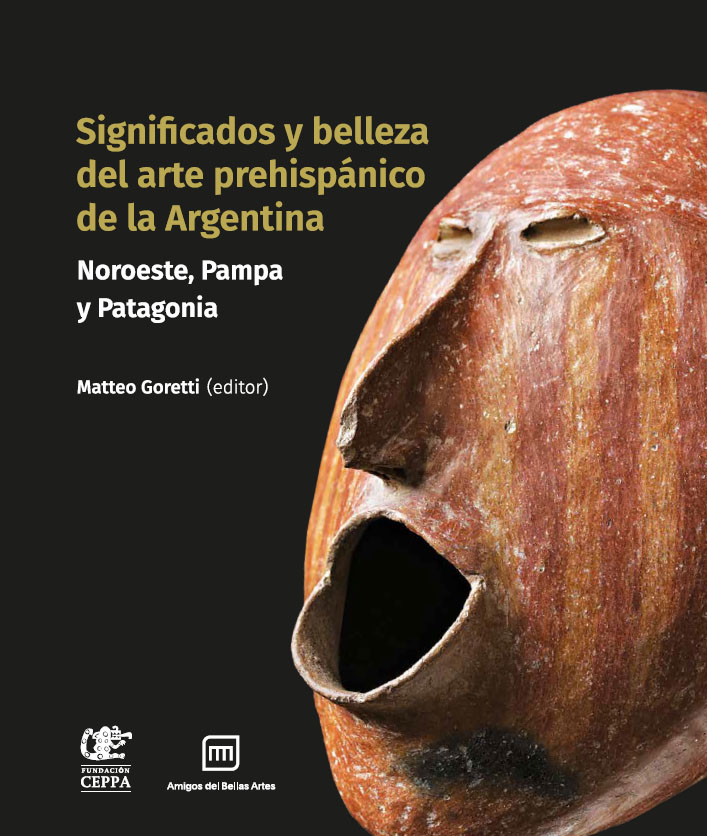Significados y belleza del arte prehispánico en la Argentina
Matteo Goretti (editor), in 4° major (29 x 24.5 cm), 428 pp. Buenos Aires. CEPPA Editions Foundation. 2023.
The work has a direct link with the donation of pre-Hispanic art to the National Museum of Fine Arts that the editor himself made in 2019: 1,583 objects belonging to different American cultures; This is indicated in the Prologue by the president of the Association of Friends of the MNBA, Julio César Crivelli.
Dedicated to four capital figures of Andean archeology -Alberto Rex González, Carlos Martínez Sarasola, José Antonio Pérez Gollán and Juan Schobinger-, the book, of great graphic quality, brings together a group of authors who guarantee excellence in their approaches.
José Emilio Burucúa sets his sights on the collections of pre-Hispanic art exhibited in the National Museum of Fine Arts - those formed by Guido Di Tella, Matteo Goretti and Francisco Hirsh, in fact, only a selection of this on loan from the Ministry of Foreign Affairs Exteriors - and reflects on the concept of art in pre-Hispanic societies.
Daniel Schavelzon, together with Ana Igareta, delve into the labyrinths of collecting, tracing a route from the cabinets of curiosities to the National Museum of Fine Arts, rescuing the essence of collecting with curiosity, a practice that led to modern science. In its text we learn of the first record of an archaeological work; It happened in Mesopotamia, the territory delimited by the Euphrates and Tigris rivers, back in the 14th century BC. And with an agile pen they advance through the civilizations of Greece and Rome, always making history and art a political tool at the service of the State - they explain -, capable of constructing a new past, justifying invasions and showing themselves victorious even in defeats. …His chapter finally delves into the history of collecting in Argentina throughout more than a century of encounters and disagreements between the State, archaeology, private collectors and art.
The archaeologist Ana María Llamazares, for her part, alludes to “the beauty of others” and its entry - with a permanent room - to the National Museum of Fine Arts, the Argentine cathedral of art, where the plastic manifestations created and brought together by who identify ourselves as peers: “enlightened white people, sensitive and original creators, the owners of refined taste and the ability to appreciate the beautiful.” This break, he highlights, thus settles a long and old debt.
In the following chapter, Néstor Kriscautky advances in time and space through the different settlements of the northwest, drawing a map with the most relevant cultures in each of the defined periods and focusing on the hybrid figures of the La Aguada culture (500 - 1000 A.D.), Matteo Goretti then addresses the manifestations that "combine human parts with those of one or several animals, or only zoomorphic ones, where biological limits are erased and result in 'monstrous' images that disconcert, such as those of the dragon, the hydra and others of a hybrid nature.
Irina Podgorny, for her part, stops at some human footprints discovered on the seashore, in Monte Hermoso, transformed "into an iconic site of the archeology of our country: one of the halls that connect the pampas, Patagonia and the ocean ». Those footprints that aroused their interest, says the team that studied them, were left by a group of hunter-gatherers seven thousand years ago; children, young people and perhaps women, who circulated along the edge of a brackish water lagoon where sea lions, snail shells and the stones necessary to make instruments abounded... In the Podgorni record, this evidence dispels and raises questions , because in his understanding life is like a wind that crosses borders in the most capricious ways. So she approaches it from this Buenos Aires beach towards the south, to the heart of Patagonia.
Finally, the oldest sumptuary arts - especially those referring to the Andean region of South America - occupy the attention of a specialist from the Metropolitan Museum of Art in New York, Joanne Pillsbury. Gold, copper, bronze and silver, as well as high-status textiles, star in this chapter. "The sumptuary arts," says Pillsbury, "deal with things that excite the senses," in general, linked to the supernatural space and intended to capture divine forces.
From page 286, the work advances through an image gallery with pre-Hispanic objects from northwest Argentina that were initially exhibited in the Permanent Room of Pre-Hispanic and Colonial Art of the MNBA when it was inaugurated in April 2019. Some time later, the pieces that They had entered on loan and belonged to the collection formed by Francisco Hirsch, they returned to the Ministry of Foreign Affairs, where they are today.
This new title, without a doubt, deserves our reading; It has the rigor and pepper that distinguishes works destined to last.
